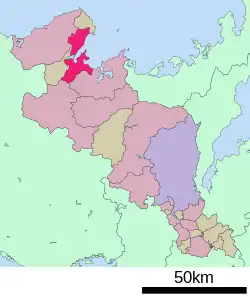Miyazu, Kyoto
Miyazu (宮津市, Miyazu-shi) is a city located in Kyoto Prefecture, Japan. As of 28 February 2022, the city had an estimated population of 16,988 in 8348 households and a population density of 98 persons per km².[1] The total area of the city is 172.74 square kilometres (66.70 sq mi).
Miyazu
宮津市 | |
|---|---|
 | |
 Flag  Emblem | |
 Location of Miyazu in Kyoto Prefecture | |
 Miyazu Location in Japan | |
| Coordinates: 35°32′N 135°12′E | |
| Country | Japan |
| Region | Kansai |
| Prefecture | Kyoto |
| Government | |
| • Mayor | Masafumi Kinosaki (since July 2018) |
| Area | |
| • Total | 172.74 km2 (66.70 sq mi) |
| Population (February 28, 2022) | |
| • Total | 16,988 |
| • Density | 98/km2 (250/sq mi) |
| Time zone | UTC+09:00 (JST) |
| City hall address | Yanaginawate 345-1, Miyazu-shi, Kyoto-fu 626-0024 |
| Climate | Cfa |
| Symbols | |
| Flower | Cryptotaenia, Azalea |
| Tree | Pinus |
Geography
Miyazu is located in the northern part of Kyoto Prefecture at the base of the Tango Peninsula, facing Wakasa Bay of the Sea of Japan to the east. Located in Miyazu City is Amanohashidate or the "bridge to heaven", said to be one of Japan's three most beautiful sights. The naturally formed land bridge is 3.6 kilometres (2.2 mi) long and covered in pine trees.
Climate
Miyazu has a humid subtropical climate (Köppen Cfa), featuring a marked seasonal variation in temperature and precipitation. Summers are hot and humid, but winters are relatively cold with occasional snowfall. The average annual temperature in Miyazu is 14.8 °C (58.6 °F).[2] The average annual rainfall is 1,917.8 mm (75.50 in) with September as the wettest month. The temperatures are highest on average in August, at around 26.8 °C (80.2 °F), and lowest in January, at around 4.1 °C (39.4 °F).[3] Its record high is 38.8 °C (101.8 °F), reached on 22 August 2018, and its record low is −7.7 °C (18.1 °F), reached on 12 February 1984.[4]
| Climate data for Miyazu (1991−2020 normals, extremes 1978−present) | |||||||||||||
|---|---|---|---|---|---|---|---|---|---|---|---|---|---|
| Month | Jan | Feb | Mar | Apr | May | Jun | Jul | Aug | Sep | Oct | Nov | Dec | Year |
| Record high °C (°F) | 18.3 (64.9) |
22.7 (72.9) |
24.4 (75.9) |
30.5 (86.9) |
33.1 (91.6) |
35.7 (96.3) |
37.8 (100.0) |
38.8 (101.8) |
36.9 (98.4) |
32.1 (89.8) |
26.0 (78.8) |
22.4 (72.3) |
38.8 (101.8) |
| Average high °C (°F) | 7.9 (46.2) |
8.6 (47.5) |
12.4 (54.3) |
17.9 (64.2) |
22.8 (73.0) |
25.9 (78.6) |
30.2 (86.4) |
31.9 (89.4) |
27.5 (81.5) |
22.2 (72.0) |
16.6 (61.9) |
10.8 (51.4) |
19.6 (67.2) |
| Daily mean °C (°F) | 4.1 (39.4) |
4.3 (39.7) |
7.4 (45.3) |
12.5 (54.5) |
17.4 (63.3) |
21.2 (70.2) |
25.5 (77.9) |
26.8 (80.2) |
22.7 (72.9) |
17.1 (62.8) |
11.8 (53.2) |
6.6 (43.9) |
14.8 (58.6) |
| Average low °C (°F) | 0.9 (33.6) |
0.6 (33.1) |
2.7 (36.9) |
7.2 (45.0) |
12.4 (54.3) |
17.3 (63.1) |
22.0 (71.6) |
22.9 (73.2) |
19.0 (66.2) |
13.1 (55.6) |
7.7 (45.9) |
3.1 (37.6) |
10.7 (51.3) |
| Record low °C (°F) | −5.8 (21.6) |
−7.7 (18.1) |
−5.2 (22.6) |
−1.9 (28.6) |
3.5 (38.3) |
7.0 (44.6) |
13.6 (56.5) |
15.2 (59.4) |
8.8 (47.8) |
2.0 (35.6) |
−1.7 (28.9) |
−4.2 (24.4) |
−7.7 (18.1) |
| Average precipitation mm (inches) | 202.9 (7.99) |
150.4 (5.92) |
136.4 (5.37) |
111.9 (4.41) |
132.8 (5.23) |
146.1 (5.75) |
199.9 (7.87) |
142.1 (5.59) |
226.9 (8.93) |
156.1 (6.15) |
124.0 (4.88) |
188.5 (7.42) |
1,917.8 (75.50) |
| Average precipitation days (≥ 1.0 mm) | 20.9 | 16.9 | 15.2 | 11.7 | 10.3 | 11.3 | 12.2 | 9.2 | 11.9 | 11.5 | 14.3 | 18.9 | 164.3 |
| Mean monthly sunshine hours | 70.6 | 84.3 | 132.5 | 180.6 | 194.5 | 142.6 | 156.0 | 200.9 | 136.7 | 137.6 | 106.4 | 81.9 | 1,621.9 |
| Source: Japan Meteorological Agency[4][3] | |||||||||||||
Demographics
Per Japanese census data,[5] the population of Miyazu in 2020 is 16,758 people. Miyazu has been conducting censuses since 1920. The city's population peaked in 1945 and has declined gradually in the decades since. It is now less than half what it was post-World War II.
| Year | Pop. | ±% |
|---|---|---|
| 1920 | 27,264 | — |
| 1925 | 29,248 | +7.3% |
| 1930 | 30,320 | +3.7% |
| 1935 | 31,628 | +4.3% |
| 1940 | 30,639 | −3.1% |
| 1945 | 36,330 | +18.6% |
| 1950 | 36,225 | −0.3% |
| 1955 | 36,200 | −0.1% |
| 1960 | 34,799 | −3.9% |
| 1965 | 33,285 | −4.4% |
| 1970 | 31,603 | −5.1% |
| 1975 | 30,194 | −4.5% |
| 1980 | 28,881 | −4.3% |
| 1985 | 27,895 | −3.4% |
| 1990 | 26,450 | −5.2% |
| 1995 | 24,937 | −5.7% |
| 2000 | 23,276 | −6.7% |
| 2005 | 21,512 | −7.6% |
| 2010 | 19,948 | −7.3% |
| 2015 | 18,426 | −7.6% |
| 2020 | 16,758 | −9.1% |
| Miyazu population statistics[5] | ||
History
The area of present-day Miyazu was part of ancient Tango Province, and was then location of the provincial capital and the Tango Kokubun-ji during the late Nara and Heian period. The area came under the control of the Isshiki clan during the Muromachi period and then to Hosokawa Tadaoki in the Sengoku period. During the Edo Period, it was largely under 70,000 koku Miyazu Domain under the Tokugawa shogunate and ruled by a cadet branch of the Matsudaira clan from Miyazu Castle. After the Meiji restoration, the town of Miyazu was established within Yosa District with the creation of the modern municipalities system on April 1, 1889. Miyazu became a port for trading with the United States and the United Kingdom in July 1899.[6] On June 1, 1954, Miyazu merged with the neighboring villages of Kunda, Yoshizu, Fuchu, Hioki, Seya, Yoro, and Higatani to form the city of Miyazu. The village of Yura was annexed on September 20, 1956,
Government
.jpg.webp)
Miyazu has a mayor-council form of government with a directly elected mayor and a unicameral city council of 14 members. Miyazu, together with the town of Yosano contributes one member to the Kyoto Prefectural Assembly. In terms of national politics, the city is part of Kyoto 5th district of the lower house of the Diet of Japan.
Economy
Miyazu has an economy based on agriculture, regional commerce, and seasonal tourism.
Education
Miyazu has six public elementary schools and three public middle schools operated by the town government and two public high schools operated by the Kyoto Prefectural Department of Education. There is also one private high school.
Transportation
Railways
![]() Kyoto Tango Railway – Miyazu Line
Kyoto Tango Railway – Miyazu Line
- Iwatakiguchi - Amanohashidate - Miyazu - Kunda - Tango-Yura
Highways
 Kyoto Jūkan Expressway: (Maizuru)- Miyazu-Amanohashidate IC
Kyoto Jūkan Expressway: (Maizuru)- Miyazu-Amanohashidate IC San'in Kinki Expressway: Yoza-Amanohashidate IC - (Yosano)
San'in Kinki Expressway: Yoza-Amanohashidate IC - (Yosano) National Route 176
National Route 176 National Route 178
National Route 178
Seaport
- Port of Miyazu

International relations
Twin towns – sister cities
| Country | City | State / Region | Since |
|---|---|---|---|
| 1976 | |||
| Delray Beach | 1977 |
Local attractions
- Ama-no-Hashidate (one of the Three Views of Japan)
- Catholic Miyazu Church
- Kono Shrine (Ichinomiya of Tango Province)
- Seikiro Ryokan (Japan Heritage・No43.Tango Chirimen Textile Road)
- Tango Kokubun-ji, National Historic Site

 Catholic Miyazu Church
Catholic Miyazu Church_otorii.JPG.webp)
.jpg.webp) Seikiro Ryokan
Seikiro Ryokan
.jpg.webp) ResortMansion of Hioki Area
ResortMansion of Hioki Area
Festival&Events

- Miyazu matsuri
References
- "Miyazu city official statistics" (in Japanese). Japan.
- Miyazu climate data
- 気象庁 / 平年値(年・月ごとの値). JMA. Retrieved March 28, 2022.
- 観測史上1~10位の値(年間を通じての値). JMA. Retrieved March 28, 2022.
- Miyazu population statistics
- US Department of State. (1906). A digest of international law as embodied in diplomatic discussions, treaties and other international agreements (John Bassett Moore, ed.), Vol. 5, p. 759.
External links
- Miyazu City official website in Japanese
- Japan guide information on Amanohashidate in English
